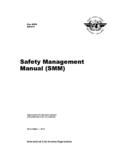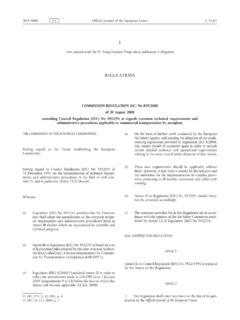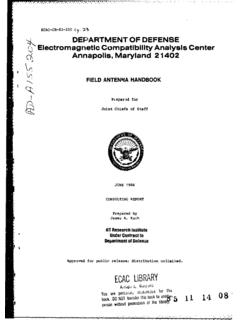Transcription of Guidelines for Controller Training in the Handling of ...
1 EUROPEAN ORGANISATIONFOR THE SAFETY OF AIR NAVIGATIONEUROCONTROLEUROPEAN AIR TRAFFIC MANAGEMENT PROGRAMMEThis Document is issued as an EATMP Guideline. The contents are not provide information and explanation or may indicate best for Controller Trainingin the Handling ofUnusual/Emergency SituationsEdition Number Date : Released IssueIntended for: EATMP Stakeholders Guidelines for Controller Training in the Handling of Unusual/Emergency SituationsPage iiReleased IssueEdition Number: CHARACTERISTICSTITLEG uidelines for Controller Training in the Handling ofUnusual/Emergency SituationsEATMP Infocentre Reference:030617-04 Document IdentifierEdition present day controllers rarely experience an unusual/emergency situation.
2 Short trainingperiods of half a day are of benefit, and the use of case studies is suggested. Checklists can help toensure a proper response. Regular pilot- Controller briefings are very TrainingSecondary Surveillance Radar (SSR) CodesASSISTU nusual/Emergency TrainingContact PersonTelUnitBrian CONSIDINE+352 436061501 Training Development and Harmonisation (TDH) UnitSTATUS, AUDIENCE AND ACCESSIBILITYS tatusIntended forAccessible viaWorking DraftoGeneral PublicoIntranetoDraftoEATMP Stakeholders ExtranetoProposed IssueoRestricted AudienceoInternet ( ) Released Issue Printed & electronic copies of the document can be obtained fromthe EATMP Infocentre (see page iii)ELECTRONIC SOURCEPath:G:\Deliverables\HUM Deliverable pdf Library\Host SystemSoftwareSizeWindows_NTMicrosoft Word for Controller Training in the Handling of Unusual/Emergency SituationsPage ivReleased IssueEdition Number: CHANGE RECORDThe following table records the complete history of the successive editions of the DATEINFOCENTREREFERENCEREASON FOR Issue for HRT19(basic document configuration) Issue, agreed at HRT19 (advanced document configuration andfinal editorial changes)AllGuidelines for Controller Training in the Handling of Unusual/Emergency SituationsEdition Number: IssuePage vCONTENTSDOCUMENT CHARACTERISTICS.
3 IiDOCUMENT APPROVAL .. iiiDOCUMENT CHANGE RECORD .. ivEXECUTIVE SUMMARY .. 11. INTRODUCTION .. and Purpose .. 32. ORGANISATION OF THE Training .. 53. ACRONYMS AND .. 84. 95. Training - GENERAL .. 116. Training PROGRAMME FOR CONTROLLERS .. 13 ANNEX A. POSTER .. 17 ANNEX B. CHECKLIST 19 REFERENCES .. 37 ABBREVIATIONS AND 39 CONTRIBUTORS .. 43 Guidelines for Controller Training in the Handling of Unusual/Emergency SituationsPage viReleased IssueEdition Number: intentionally left blankGuidelines for Controller Training in the Handling of Unusual/Emergency SituationsEdition Number: IssuePage 1 EXECUTIVE SUMMARYThis deliverable and its associated annexes are produced as a result of a workshop on thehandling of unusual incidents held at the EUROCONTROL Institute of Air NavigationServices (IANS), Luxembourg, in April presentations at the workshop were in many cases based on real incidents and it waspossible to identify the individuals concerned.
4 As this is a sensitive area, the actual workshophas not been reported on in a formal manner, but this document uses the presentations andtheir content to convey the need for continuation Training for air traffic controllers in the examples of the type of incidents are checklist is proposed for use in order to ensure proper Handling of any incident whichrequires Controller action. Suggestions for the content of such a checklist are included. Thebackground material has been provided by Germany, Switzerland, The United Kingdom andThe Netherlands. Additional input and advice was provided by aircrew personnel fromDeutsche Lufthansa (DLH).A simple set of acronyms has been provided which may make it easier for controllers toremember the immediate actions, or sequence of actions, to be followed on initial notificationof any Guidelines include some comment on the fact that pilots in general are reluctant to usethe phrases PAN PAN or MAYDAY.
5 A major exercise in conveying the real benefits of theuse of the Secondary Surveillance Radar (SSR) special codes to pilots should be embarkedon as quickly as possible, using magazine articles, seminars and joint pilot-controllerdiscussion second edition of the deliverable is intended to reflect any operational changes thathave come about since the first edition in 1999 and includes a new checklist on AirborneCollision Avoidance System (ACAS) / Traffic Alert and Collision-Avoidance System (TCAS) for Controller Training in the Handling of Unusual/Emergency SituationsPage 2 Released IssueEdition Number: intentionally left blankGuidelines for Controller Training in the Handling of Unusual/Emergency SituationsEdition Number: IssuePage 31.
6 BackgroundMany controllers in these days of improved equipment, both in the air and onthe ground, go through lengthy periods without ever having to handle anytraffic situation which presents anything out of the this trend of increased safety for the flying public is most welcome, itdoes point out the need for the Controller to be kept in practice in dealing withany situation which may arise so that when something unusual occurs safetyis not the European Air Traffic Management Programme (EATMP)1framework a Work Package, which became a Specialist Task (ST12) coveringcontinuation Training for air traffic controllers, was established at a very earlystage.
7 In that context this document was prepared to provide a brief insightinto what is possible, and what is the publication of this deliverable in June 1999 work has continuedon the development of this Training . It has now evolved to a Web-basedtraining package allowing for new print edition has been rationalised with new and updated checklistsincluding one for Airborne Collision Avoidance System (ACAS) / Traffic Alertand Collision-Avoidance System (TCAS).This deliverable is complementary to the Web-based Training (available ).Note: For the purposes of the checklist on Radio Communications Failure,the procedures in ICAO Doc 7030, Regional SupplementaryProcedures (European Region), have been Scope and PurposeThe original intention after the workshop was to produce a report whichcontained details of all of the presentations made.
8 However, on examination itwas felt that this might lead to publication of some data which could beregarded as very sensitive and possibly points very pertinent to the future Training practices in regard to thehandling of such situations were made at the workshop. The workshop pointed 1 Formerly known as the European Air Traffic Control Harmonisation and IntegrationProgramme (EATCHIP). Guidelines for Controller Training in the Handling of Unusual/Emergency SituationsPage 4 Released IssueEdition Number: areas which need to be part of an advisory service for all air trafficcontrollers. The need to keep colleagues and the supervisor in the loop wasvery noticeable, as was the need to provide an appropriate level of service tothe pilot.
9 Frequency clutter should be reduced to a minimum, the pilot shouldbe given time and space in which to make initial attempts to solve each incident, however routine, is nowadays investigated and analysed, aninternational trend became apparent which suggests that the following actionswere both desirable and necessary: discussion groups to analyse the incident and the controllers reaction; support on the counselling front for the Controller who has been in positionduring an accident or very serious incident; the creation of simulation exercises which include the pertinent parts of theaccident/ incident scenarios; the use of role playing Training Development and Harmonisation (TDH) Unit at IANS, throughthe Training Sub-Group (TSG) of the EATMP Human Resources Team (HRT),decided to create an informal working group made up of personnel fromMember States having some experience in the matter.
10 To this initial groupwere added, on a voluntary basis, two airline pilots from a major European discussion this group reached a broad consensus on a plan of action whichcould be presented to the European Civil Aviation Conference (ECAC) Statesas a guideline on how to deal with the problem, and a suggested courseformat for any for Controller Training in the Handling of Unusual/Emergency SituationsEdition Number: IssuePage 52. ORGANISATION OF THE TRAININGD ocumentation made available by DLH and Deutsche Flugsicherung (DFS),Germany, The Netherlands and Switzerland was available for discussion andfuture use. This consisted in the main of checklists and, in the case ofGermany, a description of the Joint Operational Incidents Training (JOINT)Programme currently in operation between DLH and DFS.










